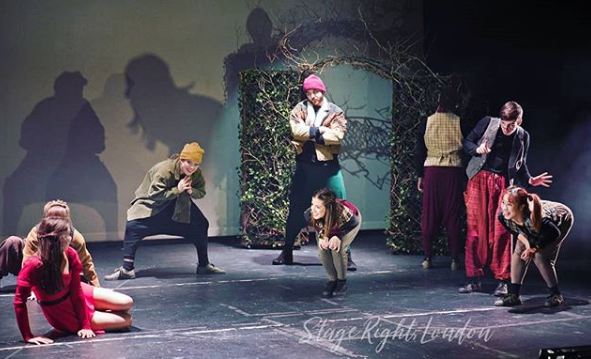
'Snow White: Reimagined' a new contemporary ballet
Photo: Stage Right London
Who’s afraid of contemporary art?
If we think of contemporary art as only suitable for experienced audiences, we are missing huge opportunities to inspire newcomers, says Naomi Wright.
There is sometimes a notion within the sector that contemporary art is ‘difficult’, classified as ‘high art’ suitable only for experienced audiences. Taking music as an example, someone without formal musical training is likely to have less preconceptions about contemporary classical music compared to traditional classical music. As a music student, one would have learnt about harmony, counterpoint, canonical composers – the music that history has told us is ‘best’. Sometimes new music, seemingly bereft of these qualities, can be labelled as ‘bad’.
Contemporary art has great potential to reach and inspire people who do not usually engage with the arts
This greatly limits the potential reach of contemporary art and is not necessarily a view held by those outside the industry. An audience without such a background has the potential to be more open when experiencing new art, and with that potential comes the opportunity for art without the constraints of convention.
Contemporary art has great potential to reach and inspire people who do not usually engage with the arts. Art created now is based on themes present in the world today and is highly relevant to our lives. It provides a live commentary on modern life, reflecting directly on current issues in a way that historical art cannot.
‘Familiarity with a twist’
Collective31 aims to create and present contemporary art to a wider, more varied audience in approachable and interesting ways. We work with a range of artforms, including music, dance and visual art, and have presented a range of innovative events including immersive concerts, interactive exhibitions and modern ballets. We believe that to attract new audiences, the sector needs to present contemporary art differently.
Collaboration between different artforms works particularly well. We have found that presenting multiple artforms creates a more engaging experience, encouraging audiences to use a wider range of senses and, therefore, feel more stimulated.
The notion of ‘familiarity with a twist’ is highly effective in making contemporary art accessible. If an event is unknown, people are less likely to attend, but introduce elements of familiarity and you've presented them with an open door. Collective31’s ‘Snow White: Reimagined’, an original contemporary ballet with a new score by Leon Haxby and choreography by Tali Foxworthy-Bowers, is a prime example. We chose to perform the work away from established dance venues in central London and instead took it to the The Compass Theatre, a small community theatre in Middlesex. To attract a new, local audience, we had to advertise the show using elements familiar to them – in this case, the well-known fairy tale of Snow White.
All shows sold near to capacity and we received overwhelmingly positive feedback, such as “I’ve never seen a ballet before but it was out of this world”.
And: “I would definitely be interested in going to see more contemporary dance shows”.
Responses from our feedback forms show 46% of the audience who responded had never seen a contemporary ballet before, yet 96% of them rated it 8/10 or above for enjoyment.
Breaking barriers
Elements other than the artform itself greatly influence an audience's perception. Sometimes just the idea of a ‘classical concert hall’ is a barrier. We often choose alternative venues like The International Anthony Burgess Foundation in Manchester, a centre that hosts artistic events in a relaxed, informal setting. Even using a theatre instead of a concert hall can change an audience's perceptions by dissipating the overriding sense of formality associated with a classical concert hall.
The size and seating arrangements of a venue also have a tangible impact. More intimate venues allow audiences to feel involved and absorbed in an event; they are no longer just an onlooker observing from afar. Traditional seating arrangements with performers on stage in front of an audience can create invisible barriers. Bringing performers and audience members into the same space produces an immersive environment. For our music and lighting event ‘Immersion’, the audience sat in the centre of the room facing outwards while the musicians performed around them. At ‘She together’, we provided rugs and cushions so audience members could sit on the floor in a relaxed and informal way. For both events the audience, completely surrounded, were captivated.
Collective31 runs outreach programmes for schools and community groups. We show participants examples of contemporary art from our events and then let them create their own work. We encourage all participants to be creative and push beyond the boundaries of ‘normality’, giving them an open and free perspective.
We believe contemporary art is the way forward to reach new, wider audiences. And by thinking laterally about how events are set and presented, and made relevant to today, it can be made accessible. With fewer preconceptions and a direct contextual understanding, people with no background in the arts make perfect audiences for contemporary work.
Naomi Wright is Artistic Director and Founder of Collective31, and a freelance musician.
Collective31 is a not-for-profit organisation which aims to make contemporary art accessible to a wide and diverse audience. We work with emerging artists to create engaging events and facilitate outreach workshops for people with no background in the arts.
collective31.com
[email protected]
Tw @collective31uk
IG @collective31uk
Facebook @collective31uk
Join the Discussion
You must be logged in to post a comment.